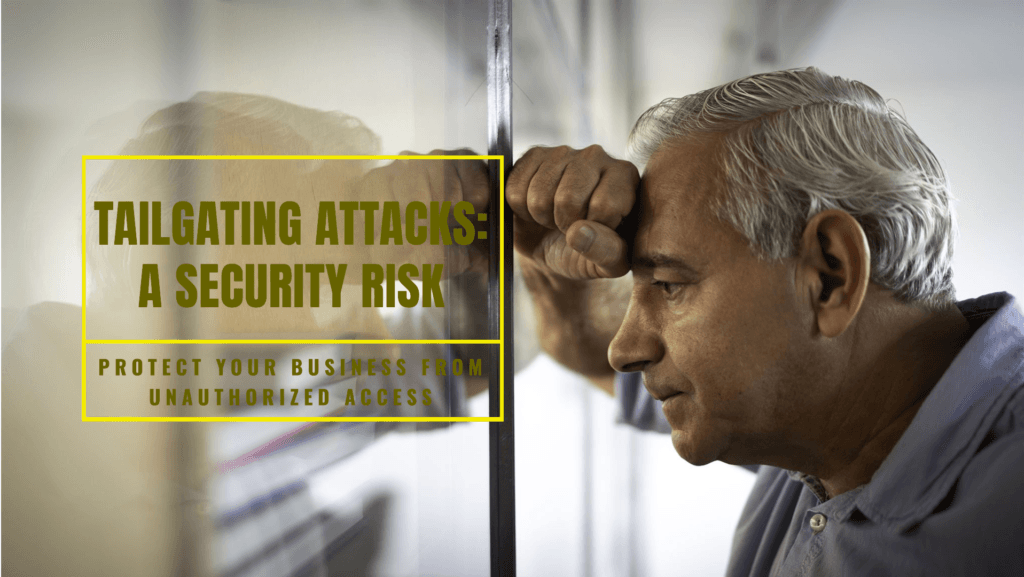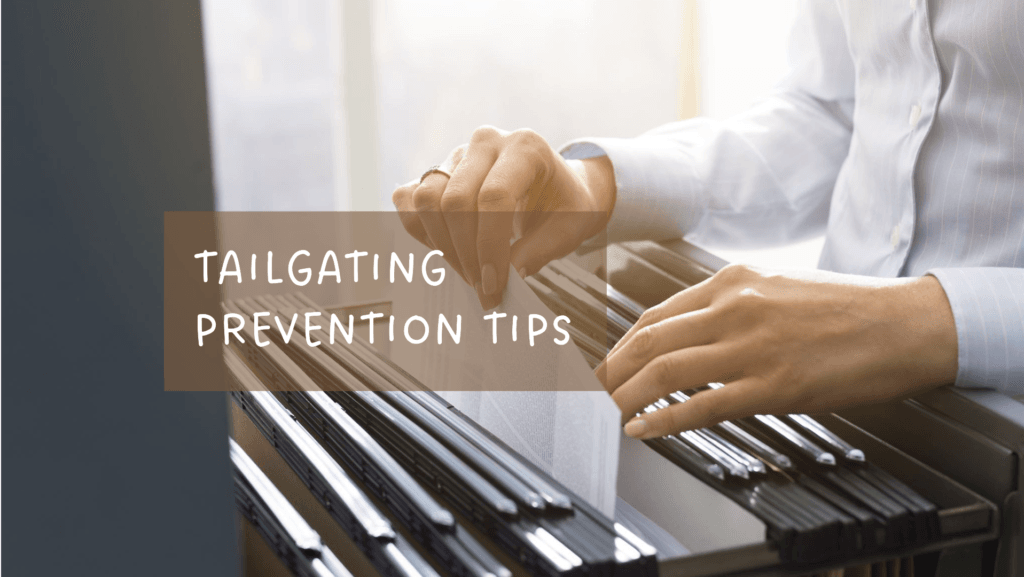In a world where security breaches can compromise entire networks and sensitive data, physical security has become just as critical as digital safeguards. Tailgating attacks—where unauthorized individuals follow someone into restricted areas—pose a significant threat to organizations’ safety and integrity. From businesses safeguarding valuable assets to tech companies protecting data centers, keeping these spaces secure is essential. Our blog, Top 5 Tools for Preventing Tailgating Attacks, explores innovative solutions designed to stop tailgating in its tracks, helping companies stay a step ahead in securing their facilities and ensuring peace of mind for their employees and clients alike.
In our increasingly interconnected and security-conscious world, safeguarding physical spaces is as crucial as protecting digital assets. Tailgating, in this context, refers to when an unauthorized person follows someone with access into a restricted area without proper permission or credentials. This type of breach can happen easily, as it often relies on simple human behaviors like holding doors open for others, whether to be polite or out of habit.
Tailgating attacks pose a serious risk for organizations of all kinds. Once inside, unauthorized individuals can access sensitive areas, retrieve confidential information, damage equipment, or cause other forms of harm. This risk is especially high for businesses that handle valuable data, equipment, or intellectual property. Therefore, understanding and addressing tailgating is essential to maintaining a secure and controlled environment.
Today, a wide range of tools are available to help prevent tailgating attacks. From access control systems to security cameras with AI-powered detection, modern technology can help companies monitor, detect, and stop unauthorized entry attempts. Investing in these tools is critical, as they offer multiple layers of protection that work together to keep a company’s premises secure. By employing the right combination of these tools and fostering an awareness of tailgating risks among employees, organizations can significantly reduce the likelihood of a security breach and maintain a safe working environment.
In this article, we’ll explore the top five tools designed to help prevent tailgating attacks, breaking down how each one works, its benefits, and best practices for effective implementation.
What is a Tailgating Attack?
A tailgating attack (often called “piggybacking”) is a form of physical security breach where an unauthorized person gains entry to a secured area by closely following an authorized individual. This form of intrusion exploits trust and social etiquette, where one person holds the door open for another or where an intruder simply blends in with a group entering a secure area.
How Tailgating Happens
Tailgating commonly occurs in workplaces, data centers, laboratories, and other locations with restricted access. Here are some scenarios that illustrate how tailgating attacks typically unfold:
- Following Employees: An attacker might wait by an entrance, appearing as if they belong or pretending to be in a rush. When an authorized employee enters, they simply walk in right behind, bypassing any security checks.
- Disguising as Delivery Personnel: Tailgaters often disguise themselves as service workers, delivery personnel, or vendors. This strategy can cause employees to assume that the person is authorized without questioning or verifying their credentials.
- Taking Advantage of Crowds: In large organizations, crowded entrances are common during peak hours. An attacker can easily slip through a crowd where security checks may be less stringent.
- Relying on Social Etiquette: Social norms and politeness are often exploited in tailgating attacks. Employees may feel uncomfortable denying access or questioning someone who looks like they belong, especially if the person appears friendly or in a hurry.
Impact of Tailgating Attacks
A successful tailgating attack can have severe consequences for an organization, including theft, vandalism, espionage, and data breaches. Because these attacks provide unauthorized individuals with direct access to physical spaces, they bypass digital security measures, making it possible for them to access sensitive information or even critical systems.
In environments with highly sensitive data, such as research facilities, hospitals, or government agencies, a tailgating attack could compromise client information, intellectual property, or national security.
Recognizing the Risk and Importance of Prevention
Tailgating is especially challenging to prevent because it takes advantage of human behavior and physical spaces, unlike digital breaches that are typically thwarted by firewalls and software. Physical security tools and a well-informed team are key defenses against tailgating. Tailgating prevention measures help reduce the risk of unauthorized entry, ensuring that only authorized individuals can access restricted spaces, and thus protect both personnel and information.
Table of Contents
Why Are Tailgating Attacks a Security Risk?
Tailgating attacks represent a serious security risk because they exploit one of the most vulnerable points in physical security: human behavior and trust. Unlike high-tech cyber attacks or hacking attempts, tailgating is an attack on the physical space, where unauthorized individuals gain access by following someone with legitimate entry rights. This type of intrusion can lead to several potential issues that threaten the overall safety, confidentiality, and integrity of an organization.

1. Exposure to Sensitive Information
Tailgating allows unauthorized individuals to enter secure zones where sensitive information might be readily accessible. Once inside, an intruder can view confidential files, access restricted data on computers, or even intercept private conversations. For industries that handle highly sensitive data, such as finance, healthcare, or government agencies, these breaches can lead to significant data loss or leaks that could harm clients, patients, or citizens.
2. Physical Security Compromise
Tailgating breaches the physical security layer, opening the door for more severe security threats. Once an unauthorized person gains access to a secure area, they can steal equipment, tamper with facilities, or even cause physical harm to individuals inside. This can also lead to damages in cases where the intruder accesses restricted or hazardous areas, such as manufacturing plants or labs with dangerous chemicals, risking employee safety and compliance with health regulations.
3. Risk of Corporate Espionage
In competitive sectors, corporate espionage is a real concern, and tailgating provides an easy way for spies to access sensitive information. By following an authorized person into secure areas, competitors or malicious entities can gather intelligence on proprietary products, processes, or strategies. This type of attack can result in the loss of competitive advantage, revenue, and even reputation, as stolen ideas or products hit the market prematurely.
4. Financial Consequences
Tailgating attacks can be financially costly. Organizations may face direct financial losses due to theft, vandalism, or equipment damage caused by unauthorized intruders. Additionally, companies might have to bear costs related to data recovery, legal expenses, or settlements if the tailgating incident leads to a data breach. This can also drive up costs associated with updating security infrastructure, training employees, or repairing damage after a tailgating incident occurs.
5. Erosion of Employee Trust and Safety
An organization that suffers from frequent tailgating incidents may experience a decrease in employee morale and trust. Employees might feel unsafe if they know that unauthorized individuals can easily enter their workplace. This can affect productivity, as employees may be distracted by safety concerns or feel less committed to a company that seems unable to protect them. In the worst cases, it could lead to high turnover rates, as employees seek safer work environments.
6. Compliance and Legal Repercussions
Many industries, particularly those dealing with personal or sensitive data, must comply with strict regulatory standards for physical security. Tailgating incidents can lead to violations of these regulations, resulting in hefty fines and legal consequences. For instance, hospitals that fail to protect patient information could face fines for violating HIPAA laws, and financial institutions might breach GDPR or other privacy regulations. Non-compliance not only results in penalties but also affects an organization’s reputation and client trust.
7. Increased Vulnerability to Insider Threats
Tailgating doesn’t only allow external individuals to gain access; it can also enable existing insiders with malicious intent to infiltrate further into the company. Someone with lower-level access could exploit tailgating to enter areas beyond their clearance level, leading to data breaches, theft, or sabotage. When left unchecked, this increased vulnerability to insider threats can be even more damaging than external attacks, as insiders often know precisely what to target and how to evade detection.
Importance of Preventing Tailgating Attacks
Tailgating attacks pose a serious security threat to organizations, as they allow unauthorized individuals to gain access to restricted areas simply by following an employee or an authorized person. Preventing these types of breaches is critical for several reasons, impacting everything from the physical safety of employees to the protection of valuable assets and sensitive data. Let’s delve into why preventing tailgating is essential.
1. Safeguarding Sensitive Information
Many organizations store sensitive and confidential information on their premises, whether it’s physical files, secure servers, or proprietary technology. Tailgating can expose this valuable information to outsiders, increasing the risk of data breaches, intellectual property theft, and even financial loss. By preventing tailgating, businesses can control who enters specific areas and limit unauthorized exposure to critical data.
2. Protecting Employees and Enhancing Workplace Safety
Tailgating not only exposes data to risk but can also endanger employees. Unauthorized individuals could pose a direct threat to employee safety, especially if they have malicious intentions. In environments like government facilities, laboratories, or financial institutions, preventing tailgating helps to ensure that only trusted personnel are granted access, reducing the risk of harm to employees and fostering a safe work environment.
3. Preserving Company Reputation
When security breaches like tailgating occur, they can damage a company’s reputation, eroding trust among clients, partners, and the public. If sensitive information leaks or unauthorized individuals compromise operations, clients may lose faith in the company’s security protocols. A reputation for strong security, on the other hand, can be a competitive advantage, reassuring clients that their data and interactions are safe.
4. Reducing Financial Losses
Unauthorized access can lead to significant financial losses in multiple ways. Tailgating attacks can lead to theft or damage to expensive equipment, data loss, or downtime, each with potentially large costs. Organizations may also face hefty fines if regulatory bodies discover that their security protocols were insufficient. Preventing tailgating is thus a proactive measure to avoid these financial risks and save on costs that could arise from such security breaches.
5. Compliance with Security Regulations
Many industries, such as healthcare, finance, and government, are subject to strict regulations requiring robust security measures to protect information and access control. By effectively preventing tailgating, companies ensure they adhere to industry regulations and maintain a higher standard of operational security.
6. Boosting Employee Confidence in Security
Employees who know that their workplace is secure are more likely to feel comfortable and productive. Visible efforts to prevent unauthorized access help reinforce trust in the company’s commitment to safety. Tailgating prevention also encourages a culture of security, where employees are vigilant about who enters and exits workspaces. This collective awareness can reduce the likelihood of security breaches.
7. Preventing Potential Disruptions and Downtime
Unauthorized access can lead to disruptions in operations if individuals tamper with or damage critical infrastructure, steal or vandalize equipment, or otherwise compromise operations. Tailgating prevention measures help maintain the integrity and reliability of workplace functions, ensuring that only those with clearance have access to crucial areas.
8. Supporting a Multi-Layered Security Approach
Preventing tailgating is a key element of a layered security strategy. Access control systems, physical barriers, and surveillance can work together to reinforce one another, creating a robust security environment. Addressing tailgating specifically enhances the strength of the entire system, closing gaps that unauthorized individuals might otherwise exploit.
Overview of the Top Tools for Preventing Tailgating
Tailgating attacks, where an unauthorized person gains access to a secured area by following closely behind an authorized individual, are common yet preventable security breaches. To address this issue, a variety of specialized tools and technologies have been developed to help organizations strengthen their physical security and mitigate unauthorized entry risks. Here’s an in-depth look at some of the most effective tools available for preventing tailgating:
- Access Control Systems
Access control systems are the first line of defense against unauthorized entry. These systems restrict access to specific areas using secure methods like keycards, biometric scans (e.g., fingerprint or facial recognition), and digital codes. They’re designed to ensure that only authorized individuals can enter protected areas, making it difficult for unauthorized persons to gain entry.- Benefits: Access control systems are highly customizable and can be scaled to fit the needs of any organization. They can log entry attempts and alert security teams in case of any suspicious activity.
- Limitations: Access control systems alone may not be enough to prevent tailgating, as they rely on individual compliance. Some tailgaters may exploit these systems by closely following an authorized person through the door.
- Security Cameras with AI Detection
Modern security cameras equipped with artificial intelligence (AI) are powerful tools for identifying suspicious behavior. These cameras don’t just record footage; they can analyze it in real time to detect patterns associated with tailgating. For example, AI algorithms can spot when two people enter a secure area without both scanning their credentials.- Benefits: AI-enabled cameras can trigger instant alerts when tailgating behavior is detected, allowing security teams to take immediate action. Additionally, these systems can continue to learn over time, improving their accuracy.
- Limitations: Security cameras are effective but require consistent monitoring and regular updates to their software. They also work best as part of a comprehensive security solution, rather than on their own.
- Turnstiles and Security Barriers
Physical barriers such as turnstiles are highly effective at stopping tailgating because they are designed to only allow one person to pass through at a time. Security turnstiles require an access credential to open, such as a keycard swipe or biometric scan. Types of barriers include optical turnstiles, full-height turnstiles, and retractable barriers.- Benefits: Turnstiles create a physical boundary that tailgaters cannot easily bypass. They also provide a visual reminder to employees about secure access protocols.
- Limitations: Turnstiles can slow down the flow of people entering and exiting a building, which may be challenging during peak times. Additionally, they require regular maintenance to ensure functionality.
- Visitor Management Systems (VMS)
These systems typically require guests to sign in and obtain a temporary visitor pass, helping to ensure that only authorized visitors can access secure areas. Many VMS solutions can be integrated with access control and surveillance systems for added security.- Benefits: A VMS is particularly useful for large organizations that frequently host clients, contractors, or temporary staff. It can provide a record of all visitors, track movement, and prevent unauthorized individuals from “tailgating” employees into restricted areas.
- Limitations: Although a VMS enhances security, it requires proper oversight to ensure visitors follow protocols. It is most effective when combined with other tailgating prevention measures.
- Anti-Tailgating Devices
These specialized devices are specifically designed to detect and prevent tailgating. Anti-tailgating sensors can detect multiple people passing through a single entry point without authorization, and they immediately alert security personnel if a breach occurs. Some anti-tailgating solutions can even prevent doors from closing if multiple people attempt to enter simultaneously.- Benefits: Anti-tailgating devices provide an additional layer of security by identifying unauthorized entry in real-time. They can also be customized to detect various scenarios, such as unauthorized access or forced entry.
- Limitations: Anti-tailgating devices can be costly and are often most effective in high-security areas rather than general office spaces. Like other tools, they work best when used in conjunction with a broader security strategy.
Tool 1: Access Control Systems
Access control systems are one of the most effective tools for preventing tailgating attacks. These systems are designed to manage who can enter a building or a specific area by restricting access to authorized individuals only. By using various authentication methods, access control systems play a vital role in ensuring that only those with permission can enter restricted spaces.
How Access Control Systems WorkProximity cards are commonly used in office buildings, schools, and hospitals.
At the core of an access control system is a set of technologies that verify the identity of individuals seeking access.
- Credentialing: This is the process by which an individual’s identity is verified before being granted access. The most common forms of credentials include:
- Keycards or ID badges: These are swiped or scanned to allow entry.
- Biometric authentication: This includes fingerprint scanning, facial recognition, and iris scanning to verify an individual’s identity based on unique physical characteristics.
- PIN codes or passwords: Some systems require users to enter a code to gain access.
- Access Points: These are the physical barriers such as doors, gates, and turnstiles that the access control system secures. They are equipped with readers that detect the credentials of a person trying to enter and grant or deny access accordingly.
- Access Control Software: This is the brain of the system, managing access permissions, logs, and alerts. It can be configured to provide different levels of access depending on time, day, or location within a building.
Types of Access Control Systems
There are several types of access control systems, each with its unique way of restricting unauthorized access:
- Proximity Card-Based Systems: These systems use proximity cards or fobs that individuals carry on their person. When the user brings the card close to a reader, the system verifies the card’s credentials and grants access.
- Biometric Systems: Biometric systems take security to the next level by requiring users to authenticate themselves with their biological traits, such as fingerprints, facial features, or even retina scans. These systems are harder to bypass than traditional card systems, making them ideal for high-security areas.
- Smart Card Systems: These are similar to proximity cards but offer a higher level of security. Smart cards contain microprocessors that store encrypted data. This makes it more difficult for attackers to clone the card, as compared to simple proximity cards.
- Mobile Access Systems: With the rise of smartphones, many access control systems now allow employees to use their phones as credentials. By using Bluetooth or NFC technology, employees can unlock doors with a simple tap or by using an app on their mobile device.
Benefits of Access Control Systems
Access control systems offer numerous advantages in preventing tailgating attacks and improving overall building security:
- Prevents Unauthorized Access: The primary benefit of an access control system is that it ensures only authorized individuals can enter restricted areas. By eliminating the possibility of tailgating, these systems maintain a high level of security.
- Audit Trails and Monitoring: Most modern access control systems generate detailed logs of who entered and exited the premises and at what time. These audit trails are valuable for tracking suspicious activities and investigating security breaches.
- Customization: Access control systems can be customized to suit the needs of a business. You can define access levels based on roles, time, and location, ensuring that employees only enter the areas necessary for their tasks. For example, only high-level executives may have access to the CEO’s office, while others may be restricted from certain floors.
- Scalability: Access control systems are scalable and can grow with your business. Whether you have a small office or a large enterprise with multiple locations, these systems can be expanded to manage additional doors, offices, and users.
- Integration with Other Security Tools: Access control systems can be integrated with other security technologies like surveillance cameras, alarms, and even visitor management systems. This creates a more holistic approach to security, reducing the chances of any security loopholes.
Limitations of Access Control Systems
While access control systems are essential in preventing tailgating, they are not foolproof. Some limitations include:
- System Failures: Like any technology, access control systems can experience technical issues, such as system malfunctions or power outages. It’s essential to have backup systems in place, such as mechanical locks or fail-safe access methods.
- Human Error: If employees forget their credentials or share their access cards or PINs, it can undermine the effectiveness of the system. Education and training are crucial to minimize these risks.
- Cost: Advanced access control systems, particularly biometric and mobile access systems, can be expensive to implement and maintain.
Why Access Control Systems are Crucial for Preventing Tailgating
Tailgating happens when an unauthorized person follows an authorized individual into a restricted area. Without a robust access control system, there’s little to stop someone from simply following a legitimate employee through a door. Access control systems, by requiring unique credentials for each individual, eliminate the possibility of unauthorized individuals entering through the same access point.
For example, with biometric access control, even if an intruder tries to follow someone through a door, they will be unable to replicate the biometric data required to gain access. Similarly, with card-based systems, a tailgater would need to have the exact card and PIN, which is highly unlikely.
Tool 2: Security Cameras with AI Detection
Security cameras have been a staple in physical security systems for decades, but the integration of Artificial Intelligence (AI) is taking them to the next level. These smart cameras are designed not just to record footage but also to analyze real-time data, detect unusual behaviors, and send alerts if tailgating attempts or other security threats are identified.
How AI-Driven Security Cameras Work
Traditional security cameras only serve the purpose of capturing footage, which can be reviewed manually if needed. In contrast, AI-powered cameras incorporate advanced machine learning algorithms that enable them to recognize specific patterns, behaviors, and anomalies within the video feed. These cameras are trained to detect when someone follows an authorized person through a restricted door or entry point, thus identifying potential tailgating attempts.
Here’s how AI security cameras typically function in preventing tailgating:
- Real-time analysis: AI cameras continuously analyze the live video feed, recognizing faces, motion, and other characteristics. This real-time analysis helps the camera detect whether a person entering an area has authorization or is attempting to sneak in behind someone else.
- Pattern recognition: The AI system is trained to recognize normal behavior patterns, such as someone using an access card or entering with a valid passcode. If the system detects an abnormal sequence (e.g., one person entering followed by another without authorization), it flags the event.
- Behavioral alerts: If a tailgating attempt is detected, the camera can trigger an automatic alert to security personnel or a monitoring station. This can be done through a smartphone app, a central control system, or even an integrated alarm system.
Benefits of AI-Driven Security Cameras
- Proactive Threat Detection: Unlike traditional cameras that require a person to review footage, AI-powered cameras detect threats as they happen. This allows for a faster response and prevents delays in preventing unauthorized access.
- Reduced Human Error: With traditional systems, there’s always the risk of human oversight—missed footage, misinterpretation of incidents, or delayed reactions. AI systems are consistent and can make real-time decisions based on the trained algorithms, ensuring that tailgating is noticed immediately.
- Improved Accuracy: AI cameras can recognize subtle behaviors and patterns that may go unnoticed by the human eye. They can identify when someone is tailgating even if the person behind is trying to blend in or mimic the legitimate person’s actions.
- Integration with Other Security Systems: These cameras can be integrated with other security tools like access control systems and alarm systems. If a tailgating attempt is detected, it can automatically trigger the access control system to lock the door or alert security staff, creating a multi-layered defense.
- Remote Monitoring and Alerts: AI security cameras often come with cloud-based storage and remote monitoring capabilities. This means that security personnel or business owners can monitor feeds remotely and receive instant alerts if there’s a breach, making them ideal for businesses with multiple locations or those requiring 24/7 surveillance.
- Data-Driven Insights: AI cameras can generate detailed reports on patterns of entry, potential security breaches, and foot traffic. This can help businesses analyze trends, understand vulnerabilities in security, and optimize security policies based on the data collected over time.
Practical Use Cases for AI-Driven Security Cameras
- High-Security Facilities: AI cameras are particularly useful in high-security settings, such as government buildings, financial institutions, or tech companies. In these environments, protecting intellectual property and confidential data is critical, and preventing unauthorized access via tailgating is non-negotiable.
- Corporate Offices and Commercial Spaces: Businesses with large premises can deploy AI-driven cameras in entryways, hallways, and restricted areas to monitor for tailgating attempts. In high-traffic areas, the cameras can detect when multiple individuals are trying to enter through a single-access point, signaling a potential breach.
- Public Spaces: In airports, shopping malls, or transportation hubs, where large crowds are common, AI cameras can help identify when a person follows others into a secure zone without proper authorization.
Challenges and Considerations
While AI-powered security cameras offer significant advantages, there are also some challenges to consider:
- Privacy Concerns: As AI cameras are designed to track and analyze human behavior, some individuals might feel uncomfortable with the level of surveillance. It’s important for businesses to balance security needs with privacy regulations, ensuring transparency and compliance with laws like GDPR.
- Cost: High-quality AI security cameras can be expensive, and the cost might be prohibitive for smaller businesses. However, the investment in preventing tailgating and other security breaches can ultimately save businesses from larger financial and reputational damage in the long run.
- False Positives: While AI cameras are highly accurate, there’s still the potential for false positives, such as the system mistakenly flagging a legitimate person entering as a tailgating attempt. However, with continuous training and updates, these issues are typically minimized.
Examples of AI-Powered Security Cameras
Several leading companies are offering AI-based security cameras that specialize in detecting tailgating and other threats:
- Axis Communications: Known for their advanced IP camera technology, Axis offers cameras with built-in AI algorithms that can recognize tailgating and other unauthorized access attempts in real-time.
- Honeywell Pro-Watch: This platform combines video surveillance with AI-powered analytics, offering businesses the ability to detect suspicious behaviors, including tailgating, and trigger immediate actions.
- Avigilon (a Motorola Solutions company): Avigilon’s AI analytics can detect behaviors like tailgating, unusual crowding, and restricted area entry, providing proactive security measures.
Tool 3: Turnstiles and Security Barriers
Turnstiles and security barriers are physical security measures designed to control access to buildings or restricted areas, making them one of the most effective tools for preventing tailgating attacks. By using barriers or gates that allow only one person to pass through at a time, these systems ensure that only authorized individuals are allowed access, minimizing the risk of unauthorized entry.
How Physical Barriers Prevent Unauthorized Access
Turnstiles and security barriers work by creating a physical boundary that must be passed through in a controlled manner. These systems can be equipped with various mechanisms, including rotating arms, swinging gates, or sliding doors, to limit access to one individual at a time. When integrated with access control systems like card readers or biometric scanners, they can prevent multiple people from following a single authorized individual.
The most common types of barriers used to prevent tailgating are:
- Optical Turnstiles: These use sensors to detect unauthorized attempts to enter. They often rely on infrared beams or cameras to identify when multiple people attempt to pass through at once. If the system detects more than one person entering, the gate will not open, effectively preventing tailgating.
- Full-Height Turnstiles: These are taller, more robust turnstiles that provide higher security. They’re particularly useful for high-security environments, such as government buildings or data centers.
- Half-Height Turnstiles: These are shorter turnstiles and are often used in less sensitive areas, where full security may not be as necessary. They still offer a good level of access control but are more convenient for general use.
- Security Barriers: Security barriers can range from simple gates to more sophisticated retractable barriers and automatic sliding doors. These are often used in conjunction with other security measures, such as badge readers, to ensure that only authorized personnel can enter specific areas.
Types of Barriers Used for Tailgating Prevention
- Optical Turnstiles:
- Description: Optical turnstiles use infrared or laser sensors to detect the presence of a person and ensure that only one person is allowed to pass through at a time. They are often used in areas where aesthetics and flow efficiency are important, as they don’t have the visual impact of traditional turnstiles.
- Benefits: Optical turnstiles are sleek, modern, and less intrusive compared to full-height barriers. They allow for smoother and faster passage, making them ideal for high-traffic areas like office buildings or airports. The advanced sensors can effectively detect tailgating attempts, stopping multiple people from entering at once.
- Full-Height Turnstiles:
- Description: Full-height turnstiles are mechanical barriers that rotate in one direction to let only one person pass through at a time. These are typically used in areas where security is a top priority, such as correctional facilities, military sites, or high-security offices.
- Benefits: Full-height turnstiles are incredibly secure and difficult to bypass. They are ideal for locations with high risks of unauthorized entry. Although they may restrict the flow of people more than optical turnstiles, they provide robust security.
- Manual Barriers (Gates and Fences):
- Description: Manual security barriers are often used in combination with access control systems to restrict unauthorized access to specific zones. These can include gates that must be opened by a security officer or a control system.
- Benefits: Manual barriers can be highly flexible in terms of entry and exit points, but they are typically slower and require more human involvement. They are best used in low-traffic, high-security areas or where automation is not a priority.
- Automatic Sliding Doors:
- Description: Automatic sliding doors that use sensors to detect authorized entry can be linked to security systems. These doors are commonly used in commercial buildings or facilities that need high traffic flow but still want to control who enters specific areas.
- Benefits: They allow for smooth, quick entry while still ensuring that unauthorized personnel cannot sneak in. Many automatic sliding doors also feature security sensors that ensure only one person passes through at a time.
Pros and Cons of Turnstiles and Security Barriers
Pros:
- Prevents Tailgating: One of the key advantages of turnstiles and barriers is their ability to effectively prevent tailgating. By physically restricting access to one individual at a time, these barriers make it difficult for unauthorized individuals to gain entry.
- Increased Security: Whether using optical or full-height turnstiles, these tools significantly enhance the security of any facility by controlling the flow of people and ensuring that only authorized personnel can enter restricted zones.
- Integration with Other Systems: Turnstiles can be integrated with other security technologies, such as biometric scanners, card readers, and video surveillance systems, creating a multi-layered security solution that enhances both physical and data protection.
- User-Friendliness: In high-traffic areas, optical turnstiles and automatic barriers provide a smooth and efficient way for people to enter, ensuring minimal disruptions while maintaining security.
Cons:
- Cost: High-quality turnstiles, especially full-height ones, can be expensive, particularly if you’re outfitting a large building with multiple entry points.
- Traffic Flow: While optical turnstiles are more efficient than manual barriers, they can still slow down foot traffic when people aren’t familiar with the system or when the system malfunctions.
- Maintenance: Turnstiles and barriers require regular maintenance to ensure that they continue to function effectively. Malfunctions, like faulty sensors or jams, can create vulnerabilities in the security system.
Best Practices for Using Turnstiles and Security Barriers
- Proper Training: Make sure employees understand how to use access control systems and the importance of not allowing tailgating by holding the door for others.
- Regular Maintenance: Ensure that turnstiles and barriers are regularly inspected and maintained to avoid malfunctions that could compromise security.
- Complement with Other Security Measures: While turnstiles and barriers are effective at preventing tailgating, combining them with other security measures like video surveillance, alarms, or access control systems can create a more robust defense against unauthorized access.
Tool 4: Visitor Management Systems (VMS)
A Visitor Management System (VMS) is an essential tool for controlling access to secure buildings or areas, especially in environments where tailgating could be a significant threat. These systems are designed to manage and monitor visitors, contractors, or any non-employee individuals who enter a facility. By ensuring that only authorized individuals are allowed entry, VMS helps reduce the risk of tailgating, where an unauthorized person follows an authorized individual into a restricted area.
How a Visitor Management System Works
A VMS typically functions as an integrated platform that streamlines the check-in and check-out process for visitors. Here’s how it generally works:
- Pre-Registration: Some VMS allow guests to pre-register their visit, either through an online portal or by being invited via email. This step ensures that all incoming visitors are expected and have prior approval.
- Check-In Process: Upon arrival, the visitor is required to sign in at a designated kiosk or reception area. The system may capture personal information, such as a photo, purpose of visit, host details, and a government-issued ID or access card.
- Badge Printing: Once checked in, visitors are often issued a visitor badge or a temporary access card that typically includes their name, photo, and any relevant information (like their host or the area they have permission to access). This badge helps security staff easily identify who is authorized to be on the premises.
- Real-Time Tracking: Modern VMS can track a visitor’s movements within the building in real time. This feature enables security personnel to see where visitors are located at any given moment, ensuring they stay within the areas they are allowed to access.
- Automated Notifications: If a visitor attempts to enter a restricted area, the system can send real-time alerts to security personnel. This ensures that any unauthorized entry attempt is flagged quickly.
- Check-Out Process: Visitors are required to check out upon leaving. The system logs their departure time, ensuring all visitors are accounted for and preventing the risk of anyone remaining inside the facility without authorization.
Key Benefits of VMS in Tailgating Prevention
- Identification of Visitors: The most significant advantage of a VMS is its ability to track and identify all visitors. When a visitor is issued a badge, security personnel can easily spot unauthorized individuals who may be tailgating behind an authorized guest. If someone without a badge attempts to enter, security is immediately alerted.
- Preventing Unauthorized Access: By ensuring all visitors are accounted for and properly signed in, a VMS helps prevent tailgating by reducing the chances of unauthorized people gaining access through the doors. Tailgaters may attempt to slip past security when doors are held open for legitimate visitors, but a visitor management system ensures that the visitor is registered, verified, and authorized for entry.
- Controlled Entry Points: Some VMS systems can be integrated with physical access control systems, such as card readers or turnstiles. This integration ensures that only visitors with valid access credentials can enter specific areas. Unauthorized individuals who attempt to follow someone through the door will be detected, as they won’t have the required badge or access permissions.
- Visitor Tracking and Logs: A VMS generates a digital log of who enters and exits the premises, including the times, dates, and specific areas accessed. This is useful for auditing and investigating any security breaches, including tailgating incidents. If a security breach does occur, security personnel can refer to the visitor log to track down the source of the unauthorized access.
- Customization and Flexibility: Visitor management systems can be customized to suit different organizational needs. For example, some systems allow for different levels of access, ensuring that high-security areas are only accessible to authorized personnel and approved visitors, effectively reducing the risk of unauthorized individuals entering restricted zones.
Integrations with Other Security Tools
A VMS doesn’t operate in isolation. It can be integrated with other physical security measures like access control systems, security cameras, and turnstiles. For example:
- When a visitor’s badge is scanned at an access point, it can trigger a turnstile or gate to open, but only if the visitor has proper access privileges.
- VMS data can be linked with security cameras to capture video footage of who enters the building and when, providing a clear visual record for later review.
Such integrations create a more robust defense against tailgating and other forms of unauthorized access.
Real-World Applications of Visitor Management Systems
- Corporate Offices: In corporate environments, VMS is commonly used to manage the flow of clients, contractors, or other external personnel entering and exiting the building. The system ensures that all visitors are logged and verified before gaining access, reducing the chances of tailgating incidents.
- Healthcare Facilities: Hospitals and clinics require strict security protocols to protect sensitive areas such as patient rooms or medical storage. A VMS ensures that visitors are only allowed in designated areas and tracks their movement to prevent unauthorized access to restricted zones.
- Educational Institutions: Universities and schools utilize VMS to track visitors, including parents, contractors, and guest speakers. By using a system to verify each visitor’s identity, educational institutions can mitigate the risk of tailgating while ensuring a safe campus environment.
- Government Buildings: In government buildings, where access to certain areas is highly restricted, VMS systems play a critical role in identifying and controlling who enters the premises. These systems help prevent unauthorized individuals from accessing sensitive areas.
Tool 5: Anti-Tailgating Devices
Anti-tailgating devices are specialized security tools designed to prevent unauthorized individuals from gaining access to restricted areas by following an authorized person (a practice known as tailgating). These devices are crucial for ensuring that security protocols are not bypassed and that only individuals with valid credentials are allowed into secure spaces.
What Are Anti-Tailgating Devices?
Anti-tailgating devices are physical barriers or detection systems installed at entry points to secure areas. Their primary function is to detect and prevent unauthorized access attempts, especially when an individual attempts to enter a secured area by closely following someone who has legitimate access. These devices ensure that each person entering a space does so individually and without the risk of being followed in by someone who doesn’t have permission.
How Anti-Tailgating Devices Work
Anti-tailgating devices typically rely on sensors, cameras, and physical barriers to detect and stop tailgating attempts. There are several types of these devices, each offering unique features that enhance the security of the entry points.
- Optical Sensors and Cameras Many anti-tailgating devices use optical sensors or cameras to track the number of people entering an area. The sensors are usually integrated into turnstiles or access gates. When an authorized person enters by swiping their access card, the device ensures that only one person is allowed entry. If someone tries to follow too closely, the system triggers an alert or prevents the entry of both individuals until the situation is corrected.
- Physical Barriers Physical barriers, like turnstiles, gates, or doors, can be designed with anti-tailgating features. These barriers often include mechanisms like infrared sensors, pressure mats, or motion detection. Some devices might only allow one person to pass at a time by closing off the entry after a single person enters. If someone attempts to follow closely behind, the system detects the second individual and blocks entry.
- Biometric Integration Some advanced anti-tailgating devices incorporate biometric scanning (e.g., fingerprint or facial recognition) to ensure that each person entering the facility is properly identified. This not only prevents tailgating but also adds an extra layer of security by verifying the identity of each individual before allowing access.
- Dual-Entry Systems These systems only allow one person to pass through at a time. After the first individual enters, the system will close the barrier and require the second individual to authenticate their access separately. This ensures no one can sneak in without proper clearance.
Key Features of Anti-Tailgating Devices
- Real-time Detection and Alerts: Many anti-tailgating devices come with real-time detection systems that trigger alerts if multiple people attempt to enter together. Alerts can be sent to security personnel or trigger alarms to notify nearby individuals of the unauthorized access attempt.
- Smart Integration: Anti-tailgating devices can often be integrated with other security systems like CCTV, access control, and alarm systems. This integration allows for a more comprehensive and automated approach to securing entry points.
- Customization: Some devices are customizable, allowing businesses to set specific rules. For example, the system can be programmed to deny access after a certain number of failed attempts or automatically lock down entry points during off-hours.
Examples of Popular Anti-Tailgating Devices
- Turnstiles Turnstiles are one of the most common anti-tailgating devices. These physical barriers rotate to allow only one person to pass through at a time. Turnstiles are often equipped with sensors to detect whether multiple individuals attempt to enter together. They are suitable for high-traffic areas and provide a clear and effective deterrent to tailgating.
- Optical Turnstiles Optical turnstiles are advanced turnstile systems that use optical sensors or infrared beams to monitor the number of people entering. These systems can detect if more than one person enters at the same time and can trigger an alarm or refuse entry.
- Smart Gates Smart gates use advanced sensors, cameras, and biometric recognition to control access. They can detect tailgating by tracking the movement of individuals and ensuring that no one follows an authorized person into the secured area without authentication.
- Anti-Tailgating Doors Some security doors are equipped with sensors that detect whether a person is trying to sneak in behind someone else. These doors may require individuals to authenticate their identity before they can pass through. If the system detects more than one person, it can lock the door or send an alert.
Benefits of Anti-Tailgating Devices
- Enhanced Security: These devices significantly reduce the risk of unauthorized access to secure areas, ensuring that only individuals with valid credentials are allowed entry. This is critical for protecting sensitive data, intellectual property, or secure facilities like laboratories or server rooms.
- Automated Monitoring: Anti-tailgating systems often come with automated monitoring and alerting capabilities, reducing the need for manual monitoring by security personnel. This can improve operational efficiency while increasing security.
- Ease of Integration: Many anti-tailgating devices can be integrated with existing access control and security systems. This allows for a seamless and unified security infrastructure, where data and alerts can be centralized for easier management.
- Cost-Efficiency: While the initial investment in anti-tailgating devices may seem high, the long-term benefits of enhanced security, reduced risk of security breaches, and peace of mind make it a worthwhile investment. Additionally, these devices can reduce the need for additional security personnel.
Challenges and Considerations
Despite their effectiveness, there are a few challenges to consider when using anti-tailgating devices:
- High Traffic Areas: In locations with heavy foot traffic, anti-tailgating devices might need to be designed to handle large volumes of people quickly without creating bottlenecks. This requires devices that are not only secure but also efficient and fast.
- User Experience: Some devices may not be user-friendly or could create frustration among authorized personnel if the system falsely rejects them. Ensuring smooth access without compromising security is key.
- Cost: The installation and maintenance of anti-tailgating systems, especially those integrated with advanced biometric technology, can be costly. Organizations must weigh the security benefits against the costs involved.
Best Practices for Using Tailgating Prevention Tools
When it comes to preventing tailgating attacks, simply installing security tools isn’t enough. To ensure these tools work effectively, they need to be used as part of a comprehensive security strategy that involves both technology and human behavior. Here are some of the best practices for using tailgating prevention tools:

1. Combine Tools for Layered Security
No single tool can offer perfect protection against tailgating. Instead, combining multiple tools creates a stronger, more resilient security system. For instance, integrating access control systems with turnstiles and security cameras provides different layers of defense, each complementing the other.
- Access control systems ensure that only authorized individuals can enter the premises, but they don’t stop people from tailgating once an authorized person opens the door.
- Turnstiles or security barriers provide a physical barrier that prevents more than one person from passing through at once.
- AI-powered cameras can monitor the flow of individuals, detecting unusual behavior like someone trying to slip in behind another person.
By using these tools together, you can create a security system that catches tailgating at different points in the process.
2. Train Employees on Security Protocols
A security system is only as strong as the people using it. Training employees on proper security protocols is essential for tailgating prevention. Even with the best tools in place, human error can still allow tailgating to happen.
- Emphasize badge security: Employees should never hold doors open for someone without verifying their identity, even if they believe the person is a colleague.
- Teach the importance of not sharing access credentials: Ensure employees understand that sharing their security credentials (like keycards, PINs, or biometric data) makes the system vulnerable.
- Encourage vigilant behavior: A culture of awareness can go a long way in stopping tailgating before it becomes an issue.
3. Regularly Maintain and Update Tools
Like all security systems, tailgating prevention tools require regular maintenance to stay effective. Keeping tools updated and in good working condition ensures they can defend against evolving threats.
- Update software: If you’re using AI-powered cameras or other digital tools, ensure that the software is regularly updated to take advantage of new features or security patches.
- Inspect hardware: Periodically check physical security measures like turnstiles, gates, and access control readers to make sure they are functioning correctly. Over time, wear and tear can lead to security gaps.
- Test systems regularly: Conducting tests, like simulating a tailgating attempt, can help identify any weak spots in the security system and allow for timely improvements.
4. Integrate with Visitor Management Systems (VMS)
Visitor management systems (VMS) are an excellent way to prevent tailgating by keeping track of visitors and ensuring they follow proper protocols when entering a building. By integrating VMS with other tools like access control or turnstiles, you create a seamless system that automatically verifies visitors before allowing access.
- Automated check-ins: A VMS should allow visitors to register and receive temporary access credentials, which are automatically deactivated after their visit.
- Real-time alerts: If an unauthorized person is detected or if tailgating is attempted, the system should send real-time alerts to security personnel.
- Clear visitor protocols: VMS should enforce rules such as requiring visitors to be escorted while on the premises or ensuring they wear visible badges.
5. Monitor Security Metrics and Analytics
To continuously improve tailgating prevention efforts, you should monitor data and analytics from your security tools. This data can help identify patterns of suspicious behavior and areas where security might need strengthening.
- Security camera footage: Regularly review footage for incidents of tailgating or unauthorized access.
- Access logs: Analyze logs from access control systems to see who is entering and leaving, and whether there are any anomalies, such as repeated attempts to tailgate at specific times or locations.
- Visitor data: Track visitor entries and exits to ensure that no one is staying beyond their authorized time.
By consistently reviewing these metrics, you can spot potential threats and refine your approach to tailgating prevention.
6. Focus on Areas with Higher Risk
Certain areas of your building may be more prone to tailgating due to higher foot traffic or more valuable assets being stored there. It’s essential to prioritize security in these areas.
- High-security zones: Areas like server rooms, financial departments, or research labs often contain sensitive data or assets. Make sure these zones have more advanced security measures, such as biometric access or multi-factor authentication.
- Busy entrances: Main entryways, lobbies, or areas near elevators might be more vulnerable to tailgating because of the sheer number of people passing through. These areas may require additional tools, such as turnstiles or AI cameras that can detect suspicious patterns in the crowd.
Benefits of Using Multiple Security Layers
When it comes to preventing tailgating attacks or any security threat, relying on a single tool or method is often not enough. Just like in cybersecurity, where multi-layered defenses are used to protect networks and data, physical security benefits significantly from a multi-layered approach as well. Let’s break down why this is important and how combining different security measures can greatly enhance your ability to prevent tailgating.
1. Increased Security Effectiveness
Each security tool or method has its strengths and weaknesses. When you use multiple layers, you’re essentially creating a more comprehensive security infrastructure. If one layer fails or is bypassed, the other layers still serve as a defense. For instance, if an access control system (like a card reader) is compromised or malfunctioning, physical barriers like turnstiles or security gates will provide an additional layer of protection.
This multi-layer strategy greatly reduces the chances of a tailgating attack succeeding, as attackers would need to bypass multiple systems rather than just one.
2. Redundancy in Case of System Failures
Technology isn’t flawless. Access control systems might experience glitches, security cameras might go offline temporarily, or barriers could malfunction. However, with multiple security layers, the redundancy ensures that one failure doesn’t leave a gap in your security. If, for example, the facial recognition software in an access control system fails, physical barriers like turnstiles can still prevent unauthorized entry. Redundancy keeps security intact even when individual components encounter issues.
3. Deterred Attackers
One of the greatest advantages of layered security is the deterrent effect it has on potential attackers. Criminals or intruders are much less likely to target a building with multiple, robust security systems in place. When they see an access control system, followed by a security camera, turnstiles, and perhaps a visitor management system, they are more likely to move on to an easier target.
Layered security sends a strong message that access will be difficult, and the risk of getting caught or detected is higher, making your organization less appealing to attackers.
4. Improved Monitoring and Detection
Layered security not only focuses on preventing unauthorized entry but also on monitoring and detecting potential threats. Different systems can be used to monitor behaviors that indicate suspicious activity, such as tailgating. For example, security cameras with AI detection can immediately alert security personnel if two individuals are entering together but only one of them is authorized.
When you use multiple systems in tandem, you can gather more data points, which helps in identifying and mitigating threats faster. For example, visitor management systems can track guests in the building, while access control systems manage who enters which areas, providing a clear record of who’s been where and when.
5. Flexibility and Customization
A layered security approach is also more customizable, enabling organizations to fine-tune their systems based on their unique needs. For instance, while turnstiles may work well for some areas of the building, other spaces (like offices or conference rooms) may only need electronic access control or biometric verification. By layering different tools, businesses can adapt to varying security needs throughout their premises.
Moreover, this flexibility allows businesses to scale their security system over time as new technologies or threats emerge.
6. Easier Detection of Compromised Systems
By using several layers, the detection of compromised or bypassed systems becomes easier. For instance, if a tailgating incident occurs but is caught by a security camera or AI detection system, the event can be traced back through various layers. This makes it much easier to identify weak spots in the security protocol, allowing for quicker remediation and strengthening of those areas.
7. Better Compliance with Regulations
In many industries, security regulations are stringent, especially for handling sensitive information or protecting employees. Multiple layers of security can help organizations comply with these regulations by ensuring that they meet industry standards for protecting facilities and data. Tools like access control systems, visitor management, and anti-tailgating devices can help meet specific compliance requirements for secure access.
Challenges in Preventing Tailgating Attacks
While there are numerous tools and technologies available to prevent tailgating attacks, implementing effective security measures can be a complex task. Several challenges arise in preventing tailgating attacks, which can undermine even the best-designed security systems. Here’s a detailed look at some of the primary hurdles organizations face:
1. Human Error
Human behavior is one of the biggest challenges in preventing tailgating attacks. Even the most sophisticated security systems can be bypassed if employees or authorized personnel are not vigilant. For example, someone may inadvertently hold the door open for another individual out of politeness, not realizing they’ve just allowed an unauthorized person access to a secure area. Training employees to recognize and resist such situations is critical, but this is a continuous challenge since human behavior can be unpredictable and inconsistent.
2. Security System Overload
In many organizations, security systems can become overwhelmed by the sheer number of people accessing a building, especially during peak hours. For instance, at the start or end of the workday, there may be a rush of employees entering the building, which can make it difficult for access control systems to process each person in a timely manner. This congestion can lead to tailgating incidents, as employees may feel pressured to hold doors open or bypass security procedures to avoid delays.
Moreover, security systems such as card readers or biometric scanners might fail due to technical issues, such as software glitches or faulty hardware. This can create vulnerabilities that could be exploited by individuals trying to tailgate. Overloading security systems can thus inadvertently compromise their effectiveness.
3. Inadequate Security Infrastructure
Some organizations may not have the physical infrastructure in place to prevent tailgating. For example, they may lack the resources to install turnstiles, advanced biometric scanners, or high-quality security cameras. In such cases, basic measures such as security badges or card readers may not be enough to fully prevent unauthorized access.
Additionally, older or poorly maintained physical barriers, such as security gates or fences, may be easy to bypass or may not be properly integrated with other security systems, leaving gaps that can be exploited. The lack of an integrated security approach often makes it easier for tailgaters to slip through unnoticed.
4. Costs and Budget Constraints
Implementing comprehensive tailgating prevention measures can be expensive. High-tech security solutions like AI-powered cameras, advanced turnstiles, and biometric access systems require significant financial investment. Many small businesses or organizations with limited budgets may struggle to afford these technologies, leaving them vulnerable to tailgating attacks.
Even if an organization has the budget for these tools, maintenance and updates are additional costs to consider. Security systems require regular monitoring, software updates, and sometimes even hardware upgrades to stay effective. These ongoing costs can create a barrier to sustaining an optimal level of security.
5. Employee Resistance to Security Protocols
Employees may resist new security measures or fail to follow procedures properly. Some individuals may find security protocols time-consuming or inconvenient. For example, using a biometric scanner or accessing a secure area with a card reader may add a few extra steps to their daily routine, leading to frustration or non-compliance. Over time, employees may find ways to circumvent security measures, consciously or unconsciously, which undermines the overall system.
Another issue is “badge sharing” or allowing another person to use one’s access badge, which is an intentional act of bypassing security for convenience. While this may not be an attack per se, it can open the door for unauthorized individuals to gain access through the badged employee’s credentials.
6. Lack of Comprehensive Training
Despite the availability of security measures, organizations often overlook one of the most important aspects of tailgating prevention: employee training. If employees aren’t properly trained to recognize tailgating attempts or understand the risks associated with allowing someone to follow them into a restricted area, they may unknowingly enable such attacks. Comprehensive training programs should be implemented regularly to ensure that employees are aware of the importance of security measures and the consequences of negligence.
7. Changing Security Threats
Tailgating tactics evolve as attackers become more sophisticated. While traditional tailgating involved simply following an authorized person through a door, today’s attackers may use more strategic methods, such as social engineering, to gain entry. For instance, an attacker might pose as a delivery person or contractor and gain trust from employees, making it harder to detect unauthorized access attempts.
Additionally, attackers may work in groups to create distractions, allowing one person to tailgate while the others divert attention. These evolving tactics present a significant challenge for security systems, as they must constantly adapt to new methods of attack.
8. Technological Limitations
While security technologies such as AI-powered cameras and biometric systems can play a critical role in preventing tailgating, they are not foolproof. False positives and negatives can occur, where the system either fails to recognize a legitimate person or mistakenly identifies an unauthorized individual as authorized. This can lead to delays in granting access or incorrect blocking of legitimate employees, which might result in workarounds, such as employees allowing others in.
Furthermore, not all systems are interoperable, making it difficult to integrate older security systems with newer technology. A lack of seamless integration can create gaps in security, allowing tailgaters to exploit vulnerabilities.
Future Trends in Tailgating Prevention Technology
The future of tailgating prevention is bright, with advancements in technology constantly reshaping how businesses secure their premises. As technology evolves, so do the tactics employed by those seeking unauthorized access. Therefore, staying ahead of tailgating threats is crucial.

1. Integration of AI and Machine Learning
Artificial intelligence (AI) and machine learning (ML) are playing an increasingly critical role in tailgating prevention. These technologies are capable of learning and adapting to new patterns of behavior, making them more efficient at detecting potential security threats.
- Smart Detection: AI-driven cameras and sensors can differentiate between authorized and unauthorized people, even in crowded environments. Using facial recognition, body heat detection, and other biometric data, AI systems can identify and alert security personnel in real-time if an unauthorized person is following someone with access.
- Behavioral Analytics: ML can predict potential tailgating incidents by analyzing patterns in human movement. For instance, if a person’s behavior deviates from normal entry or exit patterns, AI systems can automatically flag this for review, helping prevent incidents before they happen.
This combination of AI and ML will make tailgating detection not only faster but also more accurate, significantly improving security systems’ overall effectiveness.
2. Biometric Authentication Systems
As biometrics technology continues to improve, more businesses are adopting it as a way to prevent tailgating. Biometric authentication involves using unique physical characteristics (fingerprints, retinal scans, facial recognition, etc.) to verify identity before granting access.
- Facial Recognition: Cameras equipped with facial recognition software can scan individuals at entry points, comparing their facial features against a secure database. If someone tries to tailgate, the system will immediately recognize the unauthorized person, triggering an alert.
- Fingerprint and Retina Scans: More companies are adopting biometric readers that use fingerprints or retina scans as part of the entry process. These systems are much harder to bypass compared to traditional access cards or PINs.
Biometric systems are set to become more sophisticated and affordable, making them an increasingly popular solution for preventing tailgating attacks.
3. Smart Access Control Systems
Future access control systems are expected to become more intelligent and integrated, providing a seamless experience while ensuring higher security standards.
- Mobile Access and NFC: With the growing use of smartphones, mobile access is likely to become the standard for secure entry. Employees can use their mobile phones as digital keys, ensuring that only authorized individuals gain access. These systems can also be paired with geo-fencing technologies to restrict entry to specific areas or times.
- Integration with IoT (Internet of Things): IoT will play a significant role in smart access systems, allowing them to communicate with other security devices, such as cameras, turnstiles, and alarm systems. For instance, if a camera detects suspicious behavior or tailgating, the access control system could automatically lock the door or sound an alert to prevent further entry.
These smart access systems will provide both increased convenience and enhanced security, making tailgating attacks more difficult to carry out.
4. Advanced Turnstiles and Security Barriers
Physical security barriers are evolving, offering more refined and effective ways to prevent tailgating. Advanced turnstiles and barriers can now use sensors, facial recognition, and even weight detection to ensure that only one person enters at a time.
- Optical Turnstiles: These turnstiles use infrared sensors to monitor movement through entry points. They’re particularly effective in high-traffic areas, where traditional turnstiles may be impractical. The sensors detect the body movement of individuals and ensure that no one is tailgating.
- Full-Height Turnstiles: These barriers are becoming more advanced, incorporating features like anti-tailgating sensors and facial recognition cameras to enhance security. They ensure that only authorized individuals can enter and prevent anyone from following close behind.
As technology advances, turnstiles will become even more sophisticated, using AI and other technologies to improve efficiency and security.
5. Connectivity to Big Data Analytics and Cloud
Tailgating prevention systems will increasingly leverage cloud technology and big data analytics to improve their efficiency. Cloud-based systems allow security teams to remotely monitor and manage multiple security devices in real-time, making it easier to detect and respond to incidents.
- Centralized Data Analysis: By collecting data from various sources (cameras, turnstiles, biometric scanners), cloud-based platforms can analyze trends and patterns to identify vulnerabilities in the security system. This allows businesses to make data-driven decisions about where to strengthen security measures.
- Predictive Analytics: By using data analytics, businesses will be able to predict potential security breaches based on patterns observed over time. This will help security teams act proactively rather than reactively, improving the overall security posture.
The integration of big data and cloud computing will enhance tailgating prevention systems, making them more responsive and smarter.
6. Enhanced Real-Time Notifications and Alerts
With the advent of faster communication networks and smarter systems, security alerts will become more immediate and detailed. These notifications will include real-time updates, with precise information about the location, time, and individuals involved.
- Instant Alerts: If tailgating is detected, security personnel will receive immediate alerts via their mobile devices or dashboards. This allows for quicker responses to suspicious activity, helping prevent any breaches before they escalate.
- Video Streaming and Playback: In the event of a security breach, systems will provide video footage of the incident in real-time, enabling security personnel to assess the situation and take appropriate action.
These features ensure that businesses remain vigilant and can quickly respond to tailgating attempts, minimizing risks.
7. Integration with Mobile Security Applications
Mobile security applications are expected to play a larger role in tailgating prevention in the future. These apps can help streamline the process of monitoring, reporting, and managing security threats.
- Mobile Authentication: Employees may use their smartphones for more than just access control. Mobile security apps will authenticate access and provide additional security features such as geo-location, allowing businesses to restrict access based on an individual’s location.
- Instant Communication with Security: In case of an emergency or suspicious behavior, security personnel can receive instant messages or video feeds through these apps, allowing them to quickly assess the situation and take action.
Mobile apps will make security management more efficient, providing a seamless experience for both employees and security personnel.
Conclusion
The conclusion of an article serves as the final opportunity to reinforce key points and leave a lasting impression on the reader. In the case of “Top 5 Tools for Preventing Tailgating Attacks,” the conclusion is essential to summarize the main ideas and emphasize the significance of using a combination of security tools to effectively prevent unauthorized access.
Here’s a detailed explanation of the “Conclusion” section:
Summary of the Importance of Preventing Tailgating
Tailgating attacks are a serious security threat that can result in significant harm, ranging from theft of sensitive information to physical breaches that endanger the safety of employees. These types of attacks often occur when an individual follows an authorized person into a restricted area, exploiting the human element of security. The conclusion should reiterate the high risk posed by tailgating and why businesses need to be proactive in preventing it. This can include reminding the reader about the potential consequences, such as data breaches, loss of intellectual property, and reputational damage.
Reinforcement of Security Measures
The tools discussed in the article, such as access control systems, security cameras with AI detection, turnstiles, visitor management systems (VMS), and anti-tailgating devices, form a layered security strategy that strengthens an organization’s defenses. The conclusion should highlight how each of these tools plays a critical role in enhancing security by controlling access, monitoring behaviors, and identifying suspicious activities.
By combining these tools, organizations can create a robust security infrastructure that reduces the likelihood of tailgating attacks. The emphasis should be on the idea that no single security measure is foolproof, and a multi-layered approach provides the most effective defense.
Encouragement to Adopt a Layered Approach
A key takeaway from the conclusion is the need for businesses to embrace a layered approach to security. Rather than relying on one tool, businesses should implement multiple solutions that work in tandem to address various aspects of security. For example, access control systems can restrict entry, while AI-powered cameras can detect unusual behavior, and turnstiles can physically block unauthorized individuals from entering restricted areas.
The conclusion should encourage companies to think holistically about security, focusing on both technology and training. Educating employees on proper access protocols and the risks of tailgating can further complement the security tools, creating a culture of vigilance and responsibility.
FAQs About Preventing Tailgating Attacks
What is the most effective tool for preventing tailgating attacks?
While no single tool can provide 100% security, a combination of tools is often the most effective way to prevent tailgating attacks. Access control systems (such as card readers or biometric scanners) combined with physical barriers like turnstiles or security gates tend to offer the highest level of security. Integrating these tools with AI-driven security cameras and visitor management systems further strengthens protection by allowing for monitoring and quick responses to suspicious behavior. Ultimately, using a layered security approach provides the best defense against tailgating.
How can a small business protect against tailgating?
For small businesses, implementing robust yet affordable tailgating prevention measures is key. Simple access control systems, such as swipe cards or PIN-based entry systems, can significantly reduce the risk of unauthorized access. In addition, installing basic physical barriers like turnstiles or mantraps can help ensure that only authorized personnel can enter sensitive areas. Educating employees about the importance of security and encouraging them to be vigilant about holding doors for others can also make a big difference. Finally, incorporating visitor management systems to register guests can help control who enters and exits the premises.
Are tailgating attacks common in all industries?
Tailgating attacks can happen in any industry, but certain sectors are more susceptible due to the nature of their operations. Industries that handle sensitive information, such as finance, healthcare, and government, are particularly vulnerable to tailgating attacks because unauthorized individuals gaining access can lead to significant data breaches. However, industries like manufacturing or retail can also be at risk, especially if they have less stringent security measures in place. Regardless of the industry, it’s important to have effective tailgating prevention tools in place.
Can tailgating prevention tools be customized?
Yes, many tailgating prevention tools are highly customizable to suit the specific needs of a business. For example, access control systems can be tailored to grant different levels of access to different individuals based on roles or departments. Similarly, visitor management systems (VMS) can be customized to track the exact time and location of visitors, ensuring that they only access authorized areas. Even anti-tailgating barriers can be customized with features like alarm triggers or visual indicators to alert security personnel if an attempt to tailgate is detected.
How do AI-based security cameras detect tailgating?
AI-based security cameras use advanced algorithms to monitor behavior and detect unusual patterns that might indicate a tailgating attempt. These cameras are capable of distinguishing between legitimate access (such as authorized personnel entering) and potential tailgating actions (like a person attempting to follow closely behind another individual without authorization). Some AI cameras are even equipped with facial recognition software, making it easier to spot unauthorized individuals in real-time. When a tailgating event is detected, the system can trigger an alarm or notify security personnel, enabling a swift response.














Hey there! It’s so important to keep our spaces secure, and I love that you’re focusing on preventing tailgating attacks! The right tools can make all the difference. Can’t wait to see your top picks!
Hi Friend Preventing tailgating is super crucial for safety, and I’m excited to hear which tools you recommend. Let’s keep our environments secure together!
Awesome choice of topic! Tailgating attacks are a real concern, but I believe with the right tools, we can effectively prevent them. Excited to check out your list!
Tailgating attacks? No thanks! I found these 5 awesome tools that help keep those sneaky intruders at bay. Definitely worth a look!
if you’re worried about tailgating attacks (who isn’t?), these top 5 tools are seriously clutch! Let’s keep our spaces safe!”